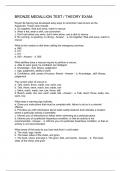BRONZE MEDALLION TEST / THEORY EXAM:
Royal Life Saving has developed easy ways to remember rules known as the Aquacode. These rules include: a. Go together, float and wave, reach to rescue b. Wear a hat, wear a shirt, use sunscreen c. Don't eat before you swim, don't swim alone, use a stick to rescue d. No running, no pushing, no diving - Answer - a. Go together, float and wave, reach to
rescue
What is the number to dial when calling the emergency services: a. 990 b. 011 c. 911 d. 000 - Answer - d. 000
What abilities does a rescuer require to perform a rescue: a. Able to swim good, be confident, be intelligent b. Knowledge , skill, fitness, judgement c. Age, judgement, ability to swim d. Confidence, skill, sense of humour, fitness - Answer - b. Knowledge , skill, fitness, judgement
The correct order of rescue is: a. Talk, reach, throw, wade, row, swim, tow b. Talk, throw, swim, reach, tow, wade, row c. Swim, reach, wade, row, tow, throw, talk d. Reach, wade, row, tow, swim, wade, talk - Answer - a. Talk, reach, throw, wade, row,
swim, tow
What does a warning sign indicate: a. Gives you instructions that must be complied with, failure to do so is a criminal offence b. Provides you with information about water safety features and indicates a location where a particular activity is permitted c. Informs you of instructions to follow when swimming at a particular place d. Informs you of a particular hazardous condition, or that an activity is not recommended - Answer - d. Informs you of a particular hazardous condition, or that an activity is not recommended
What areas of the body do you lose heat from in cold water: a. The neck, legs, hands b. The head, sides of the chest, and groin c. The back, chest, and legs d. The groin, feet, and hands - Answer - b. The head, sides of the chest, and groin What injury would a vice-grip be used: a. Broken leg b. Suspected spinal c. Dislocated shoulder d. None of the above - Answer - b. Suspected spinal
When would you use the blocking technique: a. When the person in difficulty lunges suddenly at the rescuer before it is possible for the rescuer to move away b. When the rescuer approaches a person in difficulty c. When the person in difficulty attempts to grab the rescuer d. If there is jellyfish near the person in difficulty - Answer - a. When the person in difficulty lunges suddenly at the rescuer before it is possible for the rescuer to move away
What are the 4 A's of a rescue: a. Ability, Awareness, Action, Aftercare b. Aware, Action, Aftercare, Acceptance c. Aware, Assess, Action, Aftercare d. Assess, Action, Aftercare, Aware - Answer - c. Aware, Assess, Action, Aftercare
What is the order of rescuing swimmers in difficulty: a. Unconscious, Non, Weak, Injured b. Non, Weak, Injured, Unconscious c. Weak, Injured, Non, Unconscious d. Injured, Unconscious, Non, Weak - Answer - b. Non, Weak, Injured, Unconscious
What type of breathing is used in deep water resuscitation: a. Mouth to Mouth b. Mouth to Stoma c. Mouth to Nose d. Mouth to Mouth and Nose - Answer - c. Mouth to Nose
A surging wave can: a. Knock swimmers over and carry them out to deep water b. Be sometimes called dumpers c. Be a wave caused by an underwater earthquake or landslide displacing the ocean water d. Occur when its crest tumbles down the front or face - Answer - a. Knock swimmers over and carry them out to deep water
Once assessed that a casualty is not breathing the rescuer should: a. Send for help b. Call a friend c. Check for breathing d. Commence compressions - Answer - d. Commence compressions




